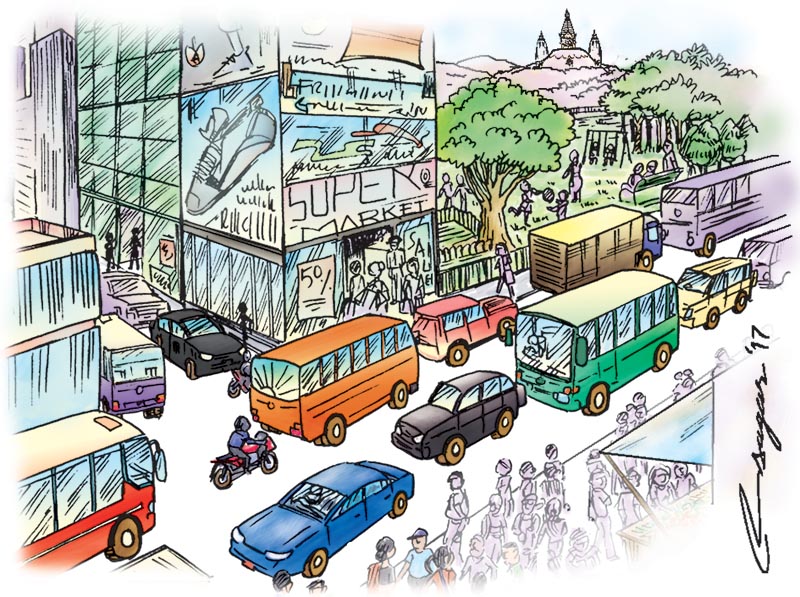Transport in Kathmandu: Fixing fallacies
Modern cities are known for their high tempo: masses of people moving to their destination on time—productivity, in general. Certainly, bicycles crisscrossing Kathmandu’s streets can seem idyllic in imagination
The federal election which will determine Nepal’s course for the next half a decade has created fault lines along the general populace. Most will probably vote along their traditional political affiliations while the younger, educated bunch might experiment with newer alternatives. But the overwhelming consensus among voters is that this election is the first one in Nepal where economic rejuvenation takes greater priority over political transformation. Kathmanduites, however, are keen on electing representatives that are steadfast in tackling the pernicious problem of pollution in the valley.
While it is highly convenient to blame haphazard road construction for the capital’s woeful air quality, we must not forget that air quality wasn’t the best even before the road widening project took root. A major chunk of the blame can certainly be attributed to the government’s mishandling of construction projects, but an equally large blame can be put on unbridled vehicular emissions.
In fact, vehicular emissions are proven to be more dangerous to human health than suspended dirt particulates. Thus, it is foolish to think that all air pollution problems will dissipate as soon as all the roads are constructed. It may provide some temporary respite but the long term solution should include cutting vehicular emissions.
Advocates of wider roads could perhaps be wrong to point out that it is the only solution to Kathmandu’s epic traffic and the pollution it brings. Urban planners of Kathmandu have made it abundantly clear that the recent road widening drive—with huge lanes compared to narrow footpaths--is to facilitate the well-off only. True, wider roads can give an impression of a modern, prosperous city, but it’s definitely not a sustainable solution.
With increasing number of Nepalis leaving their homes to pursue their “Kathmandu dream”, it is inevitable that the number of vehicles will increase. The urge of people to own their own vehicle is more of a necessity than an option since public transport is in shambles. Thus, policymakers should focus on not just reducing emissions, but controlling vehicle numbers altogether.
A simple yet effective method to achieve this goal is through taxation. The government can continue levying heavier taxes on private vehicles and motor fuel as a balancing measure to the expansion of roads. There is one caveat to this, however: this cannot be applied to trucks and mass-transport vehicles since it discourages businesses. For private vehicles, taxes can be levied by assessing its environmental impact compared to the most eco-friendly vehicle money can buy. And since we have entered into a federal structure of governance, provincial and local governments can play an influential role in abating pollution by prohibiting commercial vehicles to enter the city centre during the day.
Today, public transport in the capital operates in a “point to point” model: long routes but with little passenger demands. Prime locations in Kathmandu are already reeling under a space crunch which has forced people to shift their housing to the outskirts. This, in turn, has increased the number of vehicles of public transport connecting the city centre to the outskirts causing prolonged congestion.
An effective solution to this could be the “hub and spoke” model: shorter routes but with higher passenger demands. To illustrate my point, let us imagine a person trying to travel from Ratnapark to Godawari. Under the first model he would have to wait for an unpredictable minibus since such routes don’t have the same passenger demands at all times. Under the latter model a high capacity, timely bus would transport him/her to Satdobato intersection and from there s/he would take a smaller bus to Godawari. The end result would be fewer vehicles inside the urban centre and lesser pollution.
Unlike most urban planners, I opine that the first step we can take to tackle issues like pollution and traffic is to do away with fantasies of separate bicycle lanes everywhere and rail-based urban transportation. I espouse the “hub and spoke” model of urban public transport which can easily be served by clean, modern buses.
Modern cities are known for their high tempo: masses of people moving to their destination on time—productivity, in general. Certainly, bicycles crisscrossing Kathmandu’s streets can seem idyllic in imagination, but it cannot keep pace with a 21st century economy.
Lastly, the government can consider trading in private vehicles in return for unlimited bus rides for a certain time; let’s assume 5 years for a motorbike trader and 20 years for 5 people for a 4 wheel trader. This may sound like a malarkey at first but people can be coaxed into trading by making fuel prices prohibitively high for private users and restricting access to city centres during peak hours.
Of course this could be met with some fierce resistance of private vehicle owners who don’t want to forfeit their property, but they should also understand that this is for the long-term benefit of society. Government officials can also show solidarity through letting go off their vehicles. To some staunch liberals, this may seem as government highhandedness, but they should realize that everyone—not just the rich, inside their oasis of private vehicles—deserve the right to clean air.






